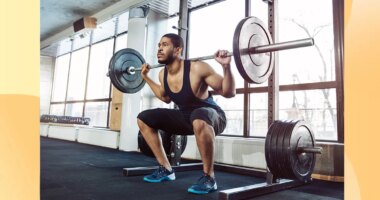
When I recently stepped into a gym after 10 years of actively avoiding such environments, I was sure all eyes would be on me. Would the weight-lifting bros laugh? Would the Lycra-clad cardio babes applaud me for trying to “improve” my figure? Would the regulars watch me on the elliptical machine, judging the ways a fat body jiggles and sways?
At 5’9″ and 280 pounds, I am big and broad and undeniably visible. Like a lot of fat people, I am told on a regular basis that I should exercise more. Like a lot of fat people, I am also told—both overtly and covertly—that I should certainly not be seen doing so.
“Fat people should have access to any public fitness space that thin people do, but the reality of navigating that is often quite daunting,” Gemma Gibson, Ph.D., a sociology expert at the University of Sheffield whose research focuses on “acceptable” fatness and contemporary body positivity, tells SELF.
During my gym visit, no overt harassment actually occurred. No one asked me about my “weight loss goals” (because why else would a fat person be at the gym, right?). No one made fun of my outfit. Or maybe they did, but I didn’t hyperfixate on it in the way I might’ve as a debilitatingly self-conscious young adult. At least on this occasion, the gym felt fairly free of public humiliation.
That’s not to say, though, that the experience was a smooth one. For instance, as a mid-fat person, I still found it very difficult to comfortably enter and use the bathroom.
In fact, accessibility issues—say, with weight machines, cardio equipment, swimming pool cubicles, and pool ladders, in addition to those bathroom stalls—can turn off larger-bodied exercisers from the gym in the first place.
READ RELATED: Animal Bite: Why Do They Bite? Symptoms, Complications, Diagnosis And Treatment
“For fat people wanting to be at the gym, there is the consideration that people might look at us, yes, but also that fitness spaces aren’t designed for us at all,” Dr. Gibson says.
Dr. Gibson tells SELF that it’s imperative to examine the systemic issues that stop fat people from exercising, while also “being careful about pushing exercise as normative and expected.” Ultimately, no one should expect or demand anything from fat people (regardless of their size, abilities, or health status), and this includes the expectation of physical fitness.
For many people, though, exercise and movement practices can be great sources of pleasure and joy, particularly when we detach these practices from anti-fat rhetoric. The benefits of getting our heart rates up are undeniable and can be pretty fun to experience if and when we find a routine and a space that we feel safe in.
For fat people who are genuinely interested in joining (or rejoining) public fitness spaces, there are some things that might help make the process feel a little less intimidating. Below, larger-bodied gym-goers have shared some words of solidarity and advice to make it easier.
1. Find a fat-positive fitness space.
“I didn’t used to see very many people who looked like me in fitness spaces, from instructors to everyone else taking the classes, so I immediately felt othered. I had situations where instructors looked me up and down when I walked in and told me that there were modifications if I needed, having no idea what my fitness level was. I also felt uncomfortable that everyone assumed I was there for weight loss. I just wanted to work out in peace without body comments, stares, and assumptions, and without wondering if someone would try to take a picture of me and post it to social media like I’ve seen happen to other fat people.
Source: SELF









